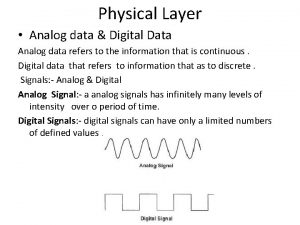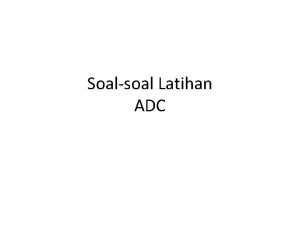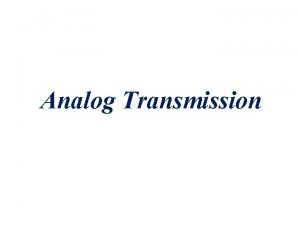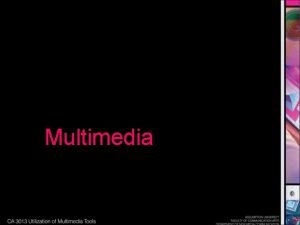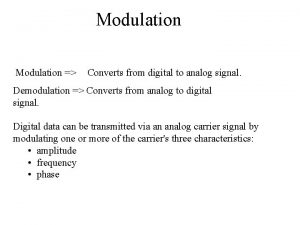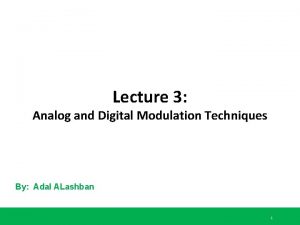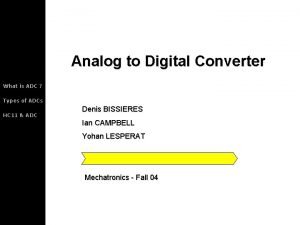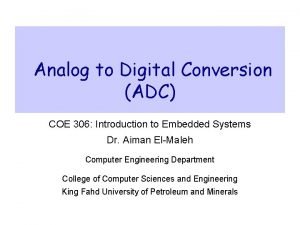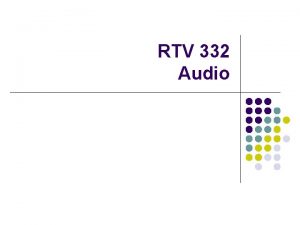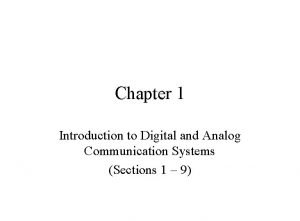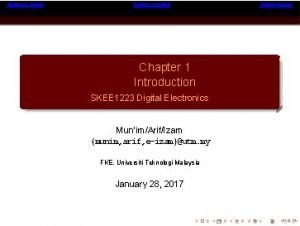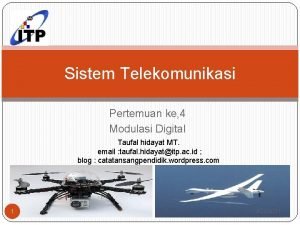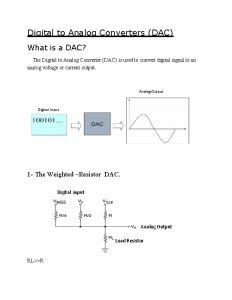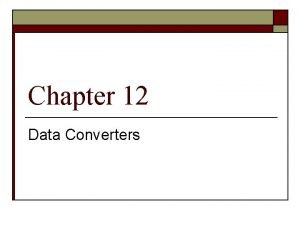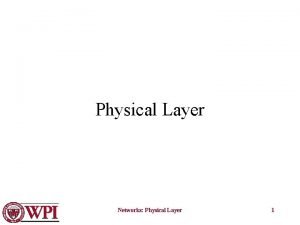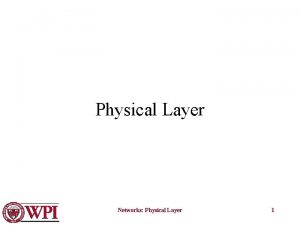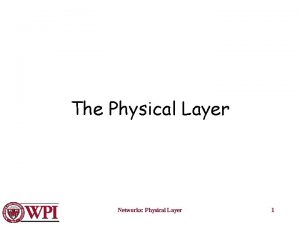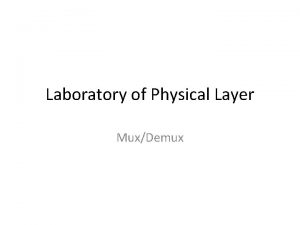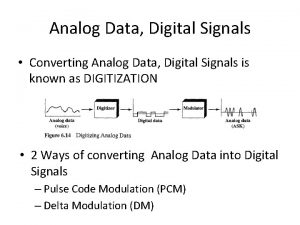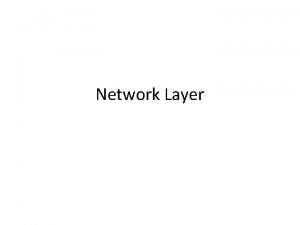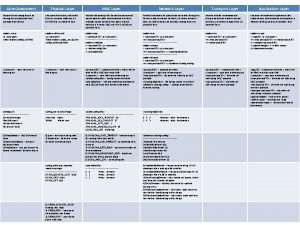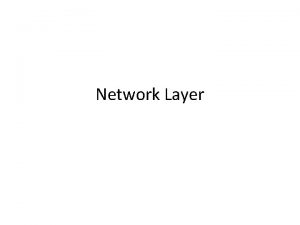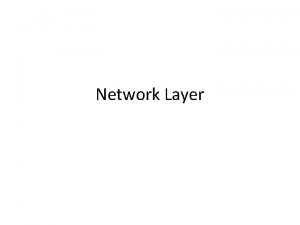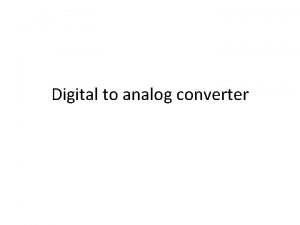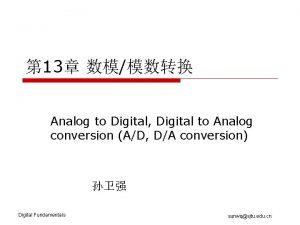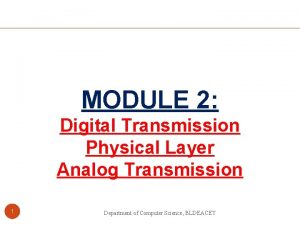Physical Layer Analog data Digital Data Analog data

































- Slides: 33

Physical Layer • Analog data & Digital Data Analog data refers to the information that is continuous. Digital data that refers to information that as to discrete. Signals: - Analog & Digital Analog Signal: - a analog signals has infinitely many levels of intensity over o period of time. Digital Signals: - digital signals can have only a limited numbers of defined values.

• Period: - Refers to amount of time in second a signal needs a completes one cycle. i. e. T=1/F • Frequency: - Refers to number of period in one second. i. e. F=1/T. Phase: - The phase describes a position of waveforms relative to time zero. it is measure in degree or radius.

Amplitude: - A peak Value of the waveform is called amplitude it is measure in Volts. Wavelength : - Wavelength is another characteristics of signal travelling through a transmission media. It is measured in λ

• Bandwidth: - The range of freq contained in composite signal is it’s bandwidth • Bit rate: It is no. of bit’s sent in one sec. And it is measured in bps. • Bit length: It is distance one bit occupies in the transmission media • Fourier Analysis: Any composite signal is combination of simple sign wave • with diff. freq, amplitude and phase, Formula is as below: - • g(t)= ½ C + ∑∞n=1 an SIN ( 2πn Ft) + ∑∞n=1 bn COS ( 2πn Ft) • • • Where, f = 1/T is fundamental freq. An and bn are the SIN and COS of amplitude. C= Constant

Transmission Impairment: Trasnmission line suffer from 3 major problems as below 1) Delay Distortion : • Distrotion is that the signal changes its form or shape. • It is caused bcoz signal and diff. freq. travel at diff speeds along the medium. • Each signal have its own speed and take own delay to reach final desti. • For digital data many bits over take slow components from bit ahead and cause incorrect data. 2) Attenuation: • It means loss of energy. • When signal travels through medium it losses some energy in medium. • e. g. A wire carrying electric signal gets warm. • To overcome this loses problem amplifiers are used to amplify the signal. • A signal travels through any medium its length decreases. • E. g our voice becomes weak over a distance and loses its beyond certain dist. • Attenuation is very small at short distance. 3)Noise: • It is another component that create problem in the receving the signal accuralty. • Signal travel any medium they will may currupt the signal. • Electromagnetic energy get inserted somewhere in transmission is called noise. • E. g. cross talk- it happens when two wires are close to each other some times when talking on telephone we hear another conversion.

Nyquiest Theorem: • It gives limit on the rate at which pulses can be sent without any inter symbol interference. • It represents with an alphabet ‘V’. • For noise less channel Nyquiest bit rate formula defines, • Bitrate = 2 x Bandwdth X Log 2 L • Where, Bandwidth = Bandwidth of channel • L= no. of signal level used to represent data • Bitrate= Bitrate in bps. • Shannon Capacity Theorem: - • It refers to the max. rate that can be attended with arbitrary asmall bit error rate. He formula is as below. • Shannon capacity = max. no. = W Log 2 ( 1+ SNR) • Where, W= Bandwidth of channel • SNR= Signla to noise ratio average signal power / average noise power • This is used to determine theoretical highest data rate for the nosiy channel.

Twisted pair Transmission Media • The most popular network cabling is Twisted pair. • It is light weight, easy to install, inexpensive and support many different types of network. • It also supports the speed of 100 mps. Twisted pair cabling is made of pairs of solid or stranded copper twisted along each other. • The twists are done to reduce vulnerably to EMI and cross talk. • The number of pairs in the cable depends on the type. • The copper core is usually 22 -AWG or 24 AWG, as measured on the American wire gauge standard. • Two types • Unshielded twisted pair (UTP) • Shielded twisted pair (STP)

Coaxial Cable • A second type of copper wire is coaxial cable, similar to that used for TV aerials. The coaxial cable provides better protection from interference by providing a metal shield. • The metal shield forms a flexible cylinder around the inner wire providing a barrier to electromagnetic radiation, both incoming and outgoing. • The cable can run parallel to other cables and can be bent round corners.

Optical Fiber • Optical fiber use light to transmit data. • A thin glass fiber is encased in a plastic jacket which allows the fiber to bend without breaking. • A transmitter at one end uses a light emitting diode (LED) or laser to send pulses of light down the fiber which are detected at the other end by a light sensitive transistor. Optical fiber have four main advantages over copper wires. • They use light which neither causes electrical interference nor are they susceptible to electrical interference • They are manufactured to reflect the light inwards, so a fiber can carry a pulse of light further than a copper wire can carry a signal • Light can encode more information that electrical signals, so they carry more information than a wire • Light can carry a signal over a single fiber, unlike electricity which requires a pair of wires

Unguided transmission media consists of a means for the data signals to travel but nothing to guide them along a specific path. Radio Transmission: • Radio waves are easy to generate, can travel long distances and penetrate buildings easily, so they are widely used for communications both indoors and outdoors. Radio waves are also omni directional, means that they travel in all directions from the source, so that the transmitter and receiver do not have to be carefully aligned physically. • The properties of radio wave are frequency dependent. At low frequencies, radio waves pass through obstacles well, but the power falls of sharply with distance from the source. At high frequencies, radio waves tend to travel in straight lines and bounces of obstacles. They are also absorbed by rain. At all frequencies, radio waves are subjected to interference from motors and other electrical equipments. • Microwave Transmission: • In the Microwave Transmission the transmitting and receiving antennas must be accurately aligned with each other. In addition, this directionality allows multiple transmitters lined up in a row to communicate with multiple receivers in a row without interference. Before fiber optics, for decades these microwaves formed the heart of long distance telephone transmission systems. • Since the microwaves travel in a straight line, if the towers are far apart, the earth will get in the way. Consequently, repeaters are needed periodically. The distance between repeaters goes up very rough, with the tower height.

• Microwave Transmission: -

Infrared Unguided infrared and millimeter waves a widely used in short–range communication. The remote controls on TV and stereos all use infrared communication. They are cheap, directional and easy to build but they do not pass through solid objects. adjacent rooms, this will gives infrared communication more security. This properties will make infrared are interesting for indoor wireless LAN’s.

Satellite Communication • A satellite is any object that revolves around a planet in a circular or elliptical path. • Satellites have many purposes including data communications, scientific applications and weather analysis. • Satellite signals must travel in straight lines but do not have the limitations of ground based wireless transmission, such as the curvature of the Earth. • The uplink is the transmitter of data to the satellite. The downlink is the receiver of data. Uplinks and downlinks are also called Earth stations because they are located on the Earth. Advantages: • High bandwidth • Coverage over a large geographical area • Can be cheaper over long distances • Disadvantages: • Huge initial cost • Noise and interference • Propagation delay

Analog Transmission : - 1) Modem • Short for modulator-demodulator. • A modem is a device or program that enables a computer to transmit data over, for example, telephone or cable lines. • Computer information is stored digitally, whereas information transmitted over telephone lines is transmitted in the form of analog waves. • A modem converts between these two forms. • The digital data of a personal computer into modulated electrical signals in the voice frequency range of a telephone channel. These signals can be transmitted over telephone lines and demodulated by another modem at the receiver side to recover the digital data.

Telephone system use circuit switching. The entire network, which is referred to as the plain old telephone system (POTS), was originally an analog system using analog signals to transmit voice. The telephone network has several levels of switching offices such as end offices, tandem offices, and regional offices. Local Loops One component of the telephone network is the local loop, a twisted-pair cable that connects the subscriber telephone to the nearest end office or local central office. Trunks are transmission media that handle the communication between offices. Switching Offices To avoid having a permanent physical link between any two subscribers, the telephone company has switches located in a switching office. Signaling The telephone network, at its beginning, used a circuit-switched network with dedicated links to transfer voice communication.

RS 232 C ( Recommended Standard 232 cable) : It is cable which is used to connectivity between Data Terminal Equipment(DTE) and Data circuit termination Equipment (DCE). It is commonly used in computer as a serial port. It is used to connect mouse , modem printer , data storage and other peripheral devices etc. It have 25 pins each pin do some activity like modem power up, clear to data send, data transmitted, data received , telephone line detected etc. The current version is TIA 232 F ( Telecommunication Industry Association)

Modulation: Amplitude Modulation: In AM transmission, the carrier signal is modulated so that its amplitude varies with the changing amplitudes of the modulating signal. The frequency and phase of the carrier remain the same; only the amplitude changes. As Fig. shows, AM is normally implemented by using a simple multiplier because the amplitude of the carrier signal needs to be changed according to the amplitude of the modulating signal.

Frequency Modulation In FM transmission, the frequency of the carrier signal is modulated to follow the changing voltage level (amplitude) of the modulating signal. The peak amplitude and phase of the carrier signal remain constant. As Fig. shows, FM is normally implemented by using a voltage-controlled oscillator as with FSK. The frequency of the oscillator changes according to the input voltage which is the amplitude of the modulating signal.

Phase Modulation In PM transmission, the phase of the carrier signal is modulated to follow the changing voltage level (amplitude) of the modulating signal. The peak amplitude and frequency of the carrier signal remain constant, In FM, the instantaneous change in the carrier frequency is proportional to the amplitude of the modulating signal; in PM the instantaneous change in the carrier frequency is proportional to the derivative of the amplitude of the modulating signal. Digital Transmission: Pulse Code Modulation The most common technique to change an analog signal to digital data (digitization) is called pulse code modulation (PCM). A PCM encoder has three processes. 1. The analog signal is sampled. 2. The sampled signal is quantized. 3. The quantized values are encoded as streams of bits.

Manchester and Differential Manchester In Manchester encoding, the duration of the bit is divided into two halves. The voltage remains at one level during the first half and moves to the other level in the second half. On the other hand, There is always a transition at the middle of the bit, but the bit values are determined at the beginning of the bit. If the next bit is 0, there is a transition; if the next bit is 1, there is none. Fig. shows both Manchester and differential Manchester encoding.

Transmission Mode The transmission of binary data across a link can be accomplished in either parallel or serial mode.

Parallel Transmission Binary data, consisting of 1 s and 0 s, may be organized into groups of n bits each. Computers produce and consume data in groups of bits much as we conceive of and use spoken language in the form of words rather than letters. By grouping, we can send data n bits at a time instead of 1. This is called parallel transmission. The advantage of parallel transmission is speed. Disadvantage: cost. Parallel transmission requires n communication lines (wires in the example) just to transmit the data stream. Because this is expensive, parallel transmission is usually limited to short distances.

Serial Transmission In serial transmission one bit follows another, so we need only one communication channel rather than n to transmit data between two communicating devices. The advantage of serial over parallel transmission is that with only one communication channel, serial transmission reduces the cost of transmission over parallel by roughly a factor of n.

Asynchronous Transmission The start and stop bits and the gap alert the receiver to the beginning and end of each byte and allow it to synchronize with the data stream. This mechanism is called asynchronous. The addition of stop and start bits and the insertion of gaps into the bit stream make asynchronous transmission slower than forms of transmission that can operate without the addition of control information. But it is cheap and effective, two advantages that make it an attractive choice for situations such as low-speed communication.

Synchronous Transmission • In synchronous transmission, the bit stream is combined into longer "frames, " which may contain multiple bytes. Each byte, however, is introduced onto the transmission link without a gap between it and the next one. • It is left to the receiver to separate the bit stream into bytes for decoding purposes. In other words, data are transmitted as an unbroken string of 1 s and Os, and the receiver separates that string into the bytes, or characters, it needs to reconstruct the information. • In synchronous transmission, we send bits one after another. The advantage of synchronous transmission is speed. Hence it is used in applications such as transmission between two computers.

Multiplexing It divides the physical linear medium in to logical segments called channels. In multiplexing, different channel carry data simultaneously over the same physical medium. Multiplexer combines the inputs from different sources, and load traverses over the medium simultaneously at the destination a de multiplexer separates the signal and sends them to their different destination.

FREQUENCY DIVISION MULTIPLEXING (FDM) : - • FDM is an analog technique that can be applied when the bandwidth of a link is greater than the combined bandwidths of the signals to be transmitted. • FDM is common technique used in public telephones and in cable TV system, where a single cable carries multiple video signals from different channels or stations to your TV set. • In this the medium is divided into no. of channels each with a frequency bandwidth, and therefore, a data rate though the composite signal ultimately carried by medium is analog , the input signal can be analog or digital.

TIME DIVISION MULTIPLEXING (TDM): • TDM is a digital process that allows several connections to share the high bandwidth of a link. Instead of sharing a portion of the bandwidth as in FDM time is shared. Each connection occupies a portion of time in the link. • The data flow of each connection is divided into units. And link combines one unit of each connection to make a frame. The size of unit can be 1 bit or several bits. For n input connection, a frame is organized into a minimum of n time slots, each slot carrying one unit from each connection.

WAVELENGTH-DIVISION MULTIPLEXING • Wavelength-division multiplexing (WDM) is designed to use the high-data-rate capability of fiber-optic cable. The optical fiber data rate is higher than the data rate of metallic transmission cable. Using a fiber-optic cable for one single line wastes the available bandwidth. • WDM is conceptually the same as FDM, except that the multiplexing and demultiplexing involve optical signals transmitted through fiber-optic channels.

SWITCHING Communication is achieved by transmitting data from source to destination through a network of intermediate nodes. CIRCUIT SWITCHING: It is simplest method of communication in which a dedicated physical path is established between the sending and receiving stations through the modes of the network. This method is used to connect two subscribes for a telephone conversation. Computers and terminals connected through a telephone network also use this method of establishing communication path among them DISADVANTAGES: • More time is required to establish the connection for data transfer. • Channel capacity is dedicated to one source for the entire duration of connection. • Method is very uneconomical when used for communication between computers. ADVANTAGES: • Once the circuit is established, data is transmitted with no delay other than propagation delay which is negligible. • It is suitable for low speed communication between a terminal and a computer. • Method is suitable for long continuous transmissions. • It is preferred method for transmission of voice and real-time data.

MESSAGE SWITCHING: - • In this method, if a station wishes to send a message to another station, it first appends the destination address to the message after this, the message is transmitted from the source to its destination. • In the store and forward method the message is transmitted from the source node to an intermediate node. The intermediate node stores the complete message temporarily inspects it for errors, and transmits it to the next node, based on an available free channel and its routing information. ADVANTAGES: 1. No physical connection is required between the source and the destination. 2. This method uses the channel very effectively. DISADVANTAGES: 1. Sufficient storage space is needed to buffer messages of unlimited length. 2. More time is required. 3. It is too slow for interactive or real time application.

PACKET SWITCHING • In packet switching, communication is discrete in form of packets. Each packet is of a limited size and can hold up to a certain number of octets of user data. Larger message are broken into smaller chunks so that they can be fitted into packets. • In addition to user data, each packet carries additional information (in form of a header) to enable the network to route it to its final destination. • A packet-switching network has a much higher capacity for accepting further connections. Advantage: Call setup phase is avoided. This is more flexible for packet routing via diff paths. Disadvantages: No guarantee about data will be delivered. Require lot of control information.

Thank You
 Analog signla
Analog signla Kuantisasi digitalisasi grayscale berjumlah... bit
Kuantisasi digitalisasi grayscale berjumlah... bit Digital to analog conversion in data communication
Digital to analog conversion in data communication Fig 19
Fig 19 Pathway of food from mouth to anus
Pathway of food from mouth to anus Secure socket layer and transport layer security
Secure socket layer and transport layer security Presentation layer functions
Presentation layer functions Secure socket layer and transport layer security
Secure socket layer and transport layer security Secure socket layer and transport layer security
Secure socket layer and transport layer security Secure socket layer and transport layer security
Secure socket layer and transport layer security Layer 2 e layer 3
Layer 2 e layer 3 Layer-by-layer assembly
Layer-by-layer assembly Layer 2 vs layer 3 bitstream
Layer 2 vs layer 3 bitstream Compare and contrast analog and digital forecasting
Compare and contrast analog and digital forecasting Pengertian teknologi digital
Pengertian teknologi digital Analogue and digital transmission
Analogue and digital transmission Analog vs digital
Analog vs digital Modulation digital to analog
Modulation digital to analog Analog and digital modulation techniques
Analog and digital modulation techniques Introduction to digital video
Introduction to digital video Difference between analog and digital editing
Difference between analog and digital editing Amw hübsch
Amw hübsch Analog to digital converter types
Analog to digital converter types Single slope adc
Single slope adc Adc adalah
Adc adalah Rtv 332
Rtv 332 Digital signal as a composite analog signal
Digital signal as a composite analog signal Analog vs digital communication systems
Analog vs digital communication systems Introduction to analog and digital electronics
Introduction to analog and digital electronics Analog image and digital image
Analog image and digital image Kelebihan dan kekurangan modulasi digital
Kelebihan dan kekurangan modulasi digital Digital to analog converter
Digital to analog converter Analogue and digital transmission in computer networks
Analogue and digital transmission in computer networks Digital to analog converters basic concepts
Digital to analog converters basic concepts
